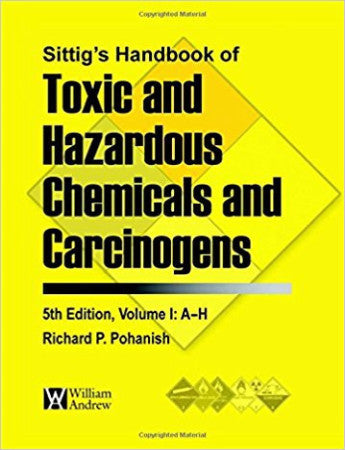Each year in the United States alone, over 350 billion pounds of toxic chemicals are manufactured and more than 8 billion pounds of these hazardous materials are transported through populated areas. It is not surprising that commercial chemical incidents occur tens of thousands of times each year, often with devastating and exorbitantly expensive consequences.
Given the reality of problems related to chemical hazards, including accidents and spills, the advent of new threats to our way of life, and the challenges of communicating complex data; Sittig’s Handbook of Toxic and Hazardous Chemicals and Carcinogens, 5th Edition provides data so that responsible decisions can be made by all who may have contact with the chemicals covered in this reference work.
Information is the most vital resource anyone can have when dealing with potential hazardous substance accidents or acts of terror. Sittig’s provides extensive data for each of the 2,100 chemicals in a uniform format, enabling fast and accurate decisions in any situation. The chemicals are presented alphabetically and classified as a carcinogen, hazardous substance, hazardous waste, or toxic pollutant. This new edition contains extensively expanded information in all 28 fields for each chemical (see the table of contents) and has been updated to keep pace with world events. Chemicals classified as WMD have been included in the new edition as has more information frequently queried by first responders and frontline industrial safety personnel.
Toxic and hazardous chemicals are manufactured in nearly every country in the world. They are a critical part of the global economy and also one of the greatest threats to our safety and security. Sittig’s Handbook has proven itself, year after year, to be one of the most important major references anyone dealing with these substances can have at their disposal. This 5th Edition will prove that it is, once again, the lone comprehensive work available.
- Molecular Formula
- Common Formula
- Synonyms
- CAS Registry Number
- When alternate numbers exist, these have been added to the 5th Edition and will also appear in the CAS Index.
- DOT ID
- DOT information has been updated to comply with the 2004 US Department of Transportation (DOT) Emergency Response Guide and classifications.
- EEC Number
- Regulatory Authority
-
The Carcinogenicity subsection has been simplified to contain the latest information from the National Cancer Institute (NCI), the National Toxicology Program (NCP), and the International Agency for Research on Cancer (IARC) with assessments and Cancer Groups 1 – 4. This is fortified with additional information on cancer in the Permissible Exposure in Air section (see below) as OSHA, NIOSH, ACGIH (American Conference of Governmental Hygienists) and the German Research Society (Deutsche Forchungsgemeinshaft) list their assessments.
- Testing information from the EPA follows carcinogen information.
- If the chemical is used as a pesticide, the EPA status is listed as supported, canceled, etc.
- Canada’s Workplace Hazardous Material Information System (WHMIS) values have been added.
-
- Cited in U.S. State Regulations
- Description
- Additional Physical Properties information has been added. Molecular weights are now present, as is vapor pressure, specific gravity, vapor density, and more.
- Potential Exposure
- Now Contains the RTECS Compound Description, and more precise usage information has been added to most entries. Also in this section, the top 50 chemicals and some production figures have been added. For example, Phenol is shown as “Top 50 chemical production; 3.71 billion pounds in 1992, 3.60 billion pounds in 1991.”
- Incompatibilities
- Permissible Exposure Limits in Air
- This section has been completely reorganized and rewritten to harmonize with the various agencies and advisory providers. It is much more readable than the 4th Edition and now shows OSHA PELs, NIOSH RELs, ACGIH TLVs and Germany’s MAKs and BATs, and NIOSH IDLHs (levels at which chemicals are immediately dangerous to life and health). This section also contains updated permissible exposure limits for countries around the world.
- Determination in Air
- This has been updated with more OSHA and NIOSH testing information.
- Permissible Concentration in Water
- Determination in Water
- The Log Kow (Octanol/water partition coefficient) has been added to this section. This is a simple, easily understood number and an indicator of potential pollution. Also, where there is information on Fish Toxicity numerical levels and ratings (LOW, INTERMEDIATE, HIGH, EXTRA HIGH) from the National Agricultural Risk Analysis Database, it is included here.
- Routes of Entry
- Harmful Effects and Symptoms
- Short Term Exposure
- Long Term Exposure
- Now contains Human Toxicity numerical levels and ratings (LOW, INTERMEDIATE, HIGH, EXTRA HIGH) from the National Agricultural Risk Analysis Database.
- Points of Attack
- Medical Surveillance
- Now contains recommended testing from NIOSH and required testing mandated by OSHA.
- Personal Protective Methods
- Now contains more specific information on protective materials for suits and gloves.
- Respirator Selection
- This section has been brought up-to-date extensively with information from the NIOSH Pocket Guide (2006 edition).
- Storage
- Shipping
- DOT information has been updated to comply with the 2004 US Department of Transportation (DOT) Emergency Response Guide and classifications.
- Spill Handling
- Now contains the Soil Absorption Index from the EPA National Agricultural Risk Analysis Database.
- Fire Extinguishing
- Now contains information on specific products of combustion. For example, many otherwise mildly hazardous chemicals can emit highly toxic fumes and gasses in the heat of fire such as sulfur oxides, nitrogen oxides, arsenic, mercury, nickel, etc.
- Disposal Method Suggested
- References




